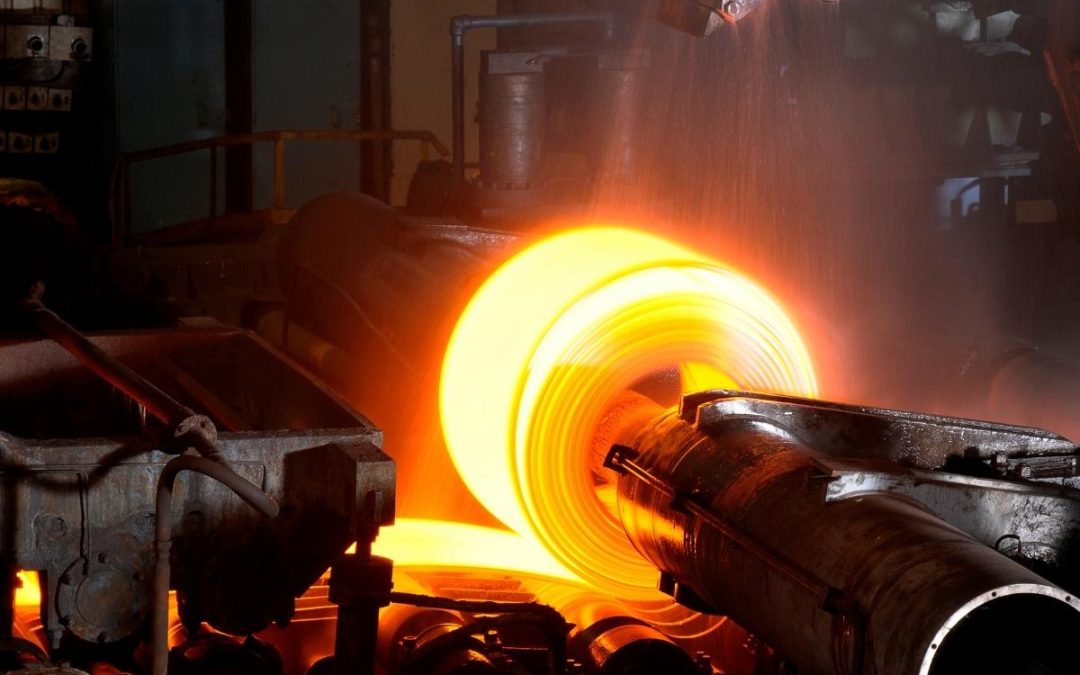Do you want to learn more about how well (or poorly) steel conducts heat, especially compared to the other material options available to you for your project? You may need to understand these concepts when selecting a steel product that will be located around heat.
Getting a material with the correct level of thermal conductivity can make the difference between a happy project manager and a dissatisfied one.
In this post, we will cover:
- Does steel conduct heat?
- What is thermal conductivity?
- Why does thermal conductivity matter?
- Wiedemann-Franz Law
Does Steel Conduct Heat?
Steel does conduct heat to some degree, but it does not conduct heat at high levels compared to many other materials.
Thermal conductivity is measured at a specific heat in Watts per meter-Kelvin (also known as an object’s “K-value”). The higher the k-value, the more heat the product conducts.
Standard carbon steel has a K-value of 50, and stainless steel has a lower K-value of 15. Stainless steel is considered a poor conductor of heat.
Keep in mind that heat conduction may vary slightly depending on the type of steel you use.
Thermal Conductivity of other Materials
Steel proves to be the exception, as many metals are considered good conductors of heat. See the K-value of the following common metals for comparison:
- Lead – 34.7
- Iron – 79.50
- Brass – 109
- Aluminum alloy – 205
- Gold – 314
- Copper – 385
- Silver – 406
- Diamond – 1000
Lead has a lower K-value than steel, but most different metals have a much higher K-value.
However, there are other materials that have lower K-values that aren’t metal:
- Glass – 0.8
- Corkboard – 0.4
- Styrofoam – 0.033
- Polyurethane – 0.02
Gases and air also have extremely low conductivity levels. However, they still conduct heat at a small degree.
Have questions about purchasing steel? We can help explain the thermal conductivity differences among Vitz Metal products, such as angle iron and steel pipe.
What is Thermal Conductivity?
What exactly is thermal conductivity? Well, it refers to how heat, or thermal energy, transfers through a material.
There are three methods of heat transfer:
- Conductivity
- Convection
- Radiation
Thermal conductivity refers to the rate at which heat naturally transfers through a material without the material moving but instead uses electrons that transfer heat energy from metal atom to metal atom.
The heat movies along what’s known as the temperature gradient from high temperature to low temperature until it creates thermal equilibrium.
Thermal conductors not only heat up quickly but also let heat escape quickly.
As an example, consider a stainless steel pan. When you touch it shortly after cooking, you will probably notice that it’s still hot. An iron pan produces very similar results to a steel pan.
Room Temperature and Thermal Conductivity
Room temperature affects the thermal conductivity of products since the free electron and the valence electron numbers both increase, causing thermal expansion and increased thermal conductivity.
Heat Conductivity Vs. Heat Capacity
Some people make the mistake of confusing thermal conductivity with other concepts, such as heat capacity.
Heat capacity refers to the amount of heat required to increase the temperature of the material.
Why Does Heat Conductivity Matter?
Heat conductivity becomes important when building things that produce a lot of heat. You may or may not want the heat transferred to the other materials in the product.
A good conductor becomes extremely important when it comes to heat exchangers, such as your toaster or your space heater, which is why most materials contain metal with high conductivity ratings. You will also find copper wire in situations that require high conductivity.
You don’t always want materials to conduct heat at high levels, though. Stainless steel and lead provide low thermal conductivity instead of allowing it to transfer to other materials, limited heat loss and allowing materials to run at higher efficiency rates. Take this into account during your selection process.
How to Manage Thermal Conductivity
You may find that steel provides adequate thermal conductivity but not perfect conductivity.
For a product with high thermal conductivity, you can use a heat shield or thermal insulator to increase its effectiveness.
See this post if you have questions about which metals can be welded.
Wiedemann-Franz Law
Sometimes, you may need to consider both thermal conductivity and electrical conductivity, and electricity obviously generates heat.
There is a significant connection between the two concepts expressed in the Wiedmann-Franz law that says:
“…at a certain temperature electrical conductivity will be proportional to thermal conductivity, however as the temperature increases, the thermal conductivity of the material will grow while the electrical conductivity will shrink.”
However, scientists recently created a new material known as vanadium dioxide that can conduct electricity without conducting heat.
Conclusion
Steel conducts heat, but it conducts heat at low rates (especially stainless steel), so it’s a great choice for highly efficient products and products that require low conductivity rates for safety reasons. It can also be abrasion-resistant.
You should remember that different steels contain different thermal conductivity ratings, and you can always test the material in question to ensure that it meets your project standards. With steel coming to the U.S from various parts of the world these days, you can’t assume a static level of quality.
Frequently Asked Questions About Steel Conductivity
Is steel a good conductor of heat?
Compared to other metals, steel tends to be a lower conductor of heat. Stainless steel conducts heat at significantly lower rates than carbon steel.
What metal conducts heat the best?
Aluminum and copper provide the highest heat conductivity rates out of standard metals, while you will get even high thermal conductivity rates from precious metals, such as gold and silver.
Why do you want low thermal conductivity?
Good thermal conductivity isn’t necessarily the best solution. Lower conductivity rates can lead to higher efficiency rates.
Does room temperature affect thermal conductivity?
Yes. Higher outside temperatures impact materials so that they conduct heat better.
About Vitz Metals
When you need a steel supplier in McKinney, TX, that you can depend on, work with Vitz Metals.
At Vitz Metals, we offer:
- Full stock & wide variety of steel products
- Quality steel, no imitations
- We can deliver metal right to your job site depending on order size
- Same-day availability
- Personal & friendly service
Our staff delivers quality products quickly and can help you learn more about the products available and what you need to get the job done.
Contact Vitz Metals today to learn more!

